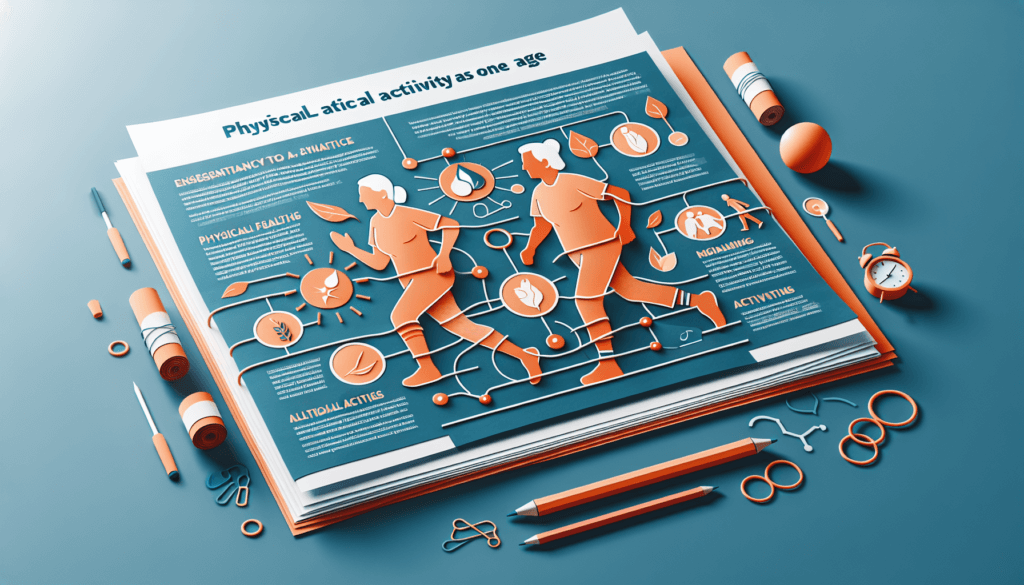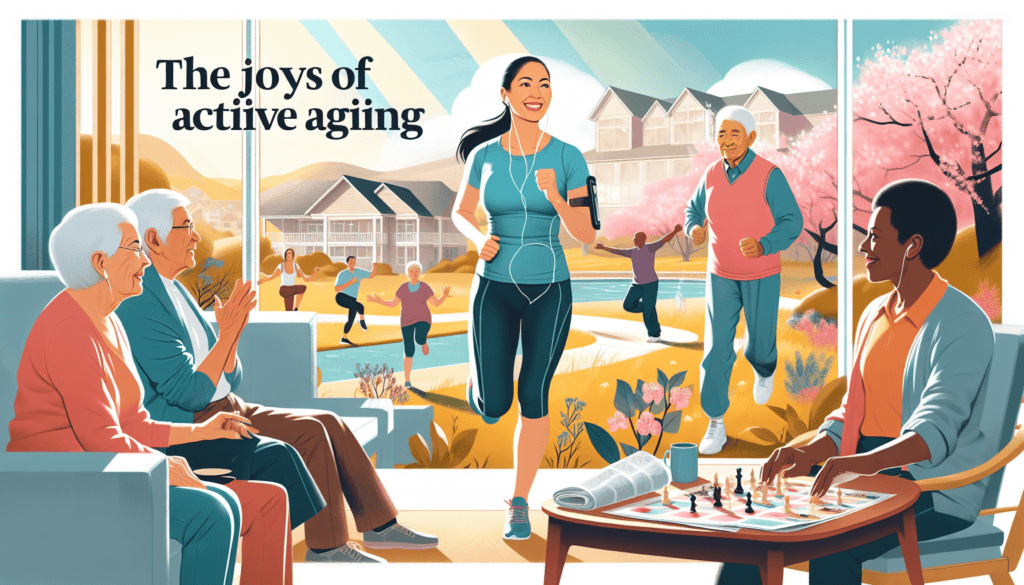As you enter the golden years of life, it becomes increasingly important to prioritize your physical activity and engagement. Maintaining an active lifestyle not only helps you stay fit and strong, but it also enhances your overall well-being and quality of life. In this article, we will explore some simple yet effective strategies to help you stay physically active and engaged as you age. From finding activities you enjoy to incorporating them into your daily routine, you’ll discover helpful tips to keep your body and mind in top shape while embracing the joys of aging. Let’s dive in!

1. Importance of Physical Activity for Seniors
Physical activity is crucial for seniors as it offers numerous benefits for their overall health and well-being. Engaging in regular exercise can lead to a higher quality of life, increased independence, and improved mental well-being. Additionally, it can help prevent or manage chronic conditions, enhance balance and flexibility, and boost cardiovascular fitness. However, it is essential to be aware of the risks associated with a sedentary lifestyle, as they can have detrimental effects on seniors’ physical and mental health.
1.1 Benefits of Physical Activity for Seniors
Regular physical activity has countless benefits for seniors. It can improve cardiovascular health, reduce the risk of heart disease and stroke, and lower blood pressure. Engaging in exercise also helps to maintain a healthy weight and increases bone density, reducing the risk of osteoporosis. Physical activity can boost the immune system, leading to a lower risk of illness and diseases.
Moreover, exercise positively impacts mental health by reducing symptoms of depression and anxiety. It enhances cognitive function and memory, reducing the risk of cognitive decline and dementia. Senior adults who are physically active also tend to have higher levels of self-esteem and overall life satisfaction.
1.2 Risks of Sedentary Lifestyle for Seniors
Leading a sedentary lifestyle poses various risks for seniors. Lack of physical activity can lead to weakened muscles and loss of bone density, increasing the risk of falls and fractures. Sedentary behavior also contributes to weight gain and obesity, which can exacerbate chronic conditions such as diabetes and heart disease.
Moreover, a sedentary lifestyle can cause stiffness in joints and muscles, leading to decreased mobility and flexibility. It can also negatively impact mental health, increasing the risk of depression, anxiety, and cognitive decline. Therefore, it is crucial for seniors to incorporate physical activity into their daily routines to mitigate these risks and maintain their health and well-being.
2. Understanding the Aging Process
As you age, it is essential to understand the physiological and psychological changes that occur in the body. By understanding these changes, you can better tailor your exercise routine and address the specific needs of your aging body.
2.1 Physiological Changes in Aging
Physiological changes during the aging process include a decrease in muscle mass and strength, reduced flexibility, and a decline in cardiovascular fitness. As you grow older, your metabolism slows down, making it easier to gain weight and harder to lose it. It is also common to experience reduced bone density, which increases the risk of fractures and osteoporosis.
Understanding these physiological changes allows you to focus on exercises that promote muscle strength, flexibility, and cardiovascular health. By incorporating strength training, flexibility exercises, and cardiovascular workouts into your routine, you can counteract these age-related changes and maintain a healthy body.
2.2 Psychological Changes in Aging
Alongside physiological changes, aging can also bring about psychological changes. These changes may include an increased risk of developing conditions such as depression and anxiety. Additionally, cognitive decline and memory loss may become more prevalent as you age.
Regular physical activity has been shown to have a positive impact on mental health. Engaging in exercise releases endorphins, which can improve mood and reduce the risk of depression and anxiety. Furthermore, physical activity stimulates the brain, promoting cognitive function and memory retention. By incorporating exercise into your routine, you can help combat these psychological changes and maintain good mental well-being.

3. Incorporating Exercise into Your Daily Routine
Incorporating exercise into your daily routine is important to ensure consistency and make it a habit. By following a structured exercise regimen, you can maximize the benefits of physical activity and maintain your overall health and well-being.
3.1 Choosing the Right Types of Exercise
When considering exercise options, it is important to choose activities that align with your interests and abilities. Low-impact exercises such as walking, swimming, and cycling are excellent choices for seniors as they are gentle on the joints while providing cardiovascular benefits. Strength training exercises, such as using resistance bands or light weights, can help maintain muscle mass and strength.
Additionally, flexibility exercises such as yoga or tai chi can improve joint mobility and reduce the risk of falls. It is crucial to engage in a variety of exercises to target different aspects of fitness and promote overall health.
3.2 Setting Realistic Goals
Setting realistic goals is essential for seniors to maintain motivation and avoid injury. Start by identifying your fitness level and considering any limitations or health conditions. Set achievable goals that align with your abilities. For example, if you are new to exercise, start with shorter durations and gradually increase the intensity and duration over time.
Remember, the goal is to enjoy being physically active and not to push yourself beyond your limits. Celebrate small milestones along the way and adjust your goals as needed. By setting realistic goals, you can make exercise a sustainable part of your daily routine.
3.3 Scheduling Regular Exercise
To ensure consistency, it is important to schedule regular exercise sessions into your daily routine. Set aside specific times for physical activity and treat them as non-negotiable appointments with yourself. This will help you prioritize your exercise and make it a priority in your life.
Whether it’s exercising early in the morning, during lunch breaks, or in the evening, find a time that works best for you and stick to it. Consider involving family members or friends in your routine to add accountability and make it more enjoyable. By scheduling regular exercise, you can establish a healthy habit that will benefit your overall well-being.
4. Strength and Resistance Training
Strength and resistance training are crucial components of a well-rounded exercise routine for seniors. These exercises help build and maintain muscle strength, improve bone density, and enhance overall functional mobility.
4.1 Benefits of Strength Training
Strength training offers numerous benefits for seniors. It helps counteract age-related muscle loss, known as sarcopenia, by increasing muscle mass and strength. As a result, strength training improves balance and stability, reducing the risk of falls and fractures. It also enhances joint function and flexibility, making everyday activities easier to perform.
Furthermore, strength training boosts metabolism, aiding in weight management and weight loss. It is also beneficial for managing chronic conditions such as arthritis and diabetes. Incorporating strength training into your routine can have a significant positive impact on your physical health and overall well-being.
4.2 Common Strength Exercises for Seniors
There are various strength exercises that are safe and effective for seniors. Bodyweight exercises, such as squats, lunges, and push-ups, can be modified to suit individual fitness levels. Resistance bands are also excellent tools for strength training, as they provide resistance without putting excessive stress on the joints.
Lightweight dumbbells or kettlebells can be used for exercises such as bicep curls, shoulder presses, and tricep extensions. It is important to start with lighter weights and gradually increase the resistance as your strength improves. Remember to maintain proper form and technique while performing these exercises to maximize their benefits and minimize the risk of injury.
4.3 Safety Tips for Strength Training
When engaging in strength training, it is crucial to prioritize safety. Start with a warm-up to prepare your muscles and joints for the exercises. Begin with lighter weights or resistance and gradually increase the intensity as your body adapts. Focus on proper form and technique to avoid straining or injuring yourself.
Allow for rest days in between strength training sessions to give your muscles time to recover and rebuild. If you have underlying health conditions or concerns, consult with a healthcare professional or a qualified fitness instructor to ensure you are performing the exercises correctly and safely.

5. Cardiovascular Exercise
Cardiovascular exercise, also known as aerobic exercise, is essential for seniors to improve heart health, maintain weight, and increase stamina. Engaging in regular cardiovascular workouts can reduce the risk of heart disease, lower blood pressure, and improve overall well-being.
5.1 Importance of Cardiovascular Exercise
Cardiovascular exercise has a host of benefits for seniors. It helps to strengthen the heart and improve its efficiency, leading to better blood circulation and oxygen transport throughout the body. Regular cardiovascular workouts can also improve lung function and increase endurance, making everyday activities easier to perform.
Moreover, aerobic exercise aids in weight management by burning calories and increasing metabolism. It helps to reduce visceral fat, which is known to increase the risk of various chronic conditions such as heart disease and diabetes. Overall, cardiovascular exercise is crucial for maintaining good heart health and promoting overall well-being.
5.2 Recommended Cardiovascular Exercises for Seniors
There are various types of cardiovascular exercises that are safe and effective for seniors. Walking is one of the simplest and most accessible exercises, requiring minimal equipment. It is a low-impact activity that can be done outdoors or indoors on a treadmill.
Swimming and water aerobics are excellent choices for seniors, as the water provides resistance without putting stress on the joints. Cycling, either outdoors or on a stationary bike, is another great option for cardiovascular exercise. Other low-impact activities, such as dancing, tai chi, and aerobics classes specifically designed for seniors, can also provide enjoyable and effective cardiovascular workouts.
5.3 Tips for Safe Cardiovascular Workouts
To ensure safe and effective cardiovascular workouts, consider the following tips:
- Start slowly and gradually increase the intensity and duration of your workouts.
- Warm up before each session and cool down afterward to prevent injury and reduce muscle soreness.
- Stay hydrated by drinking plenty of water before, during, and after exercise.
- Use appropriate footwear and clothing for your chosen activity to prevent discomfort and minimize the risk of injury.
- Listen to your body and adjust the intensity or duration of the exercise if needed. Consult with a healthcare professional if you have any concerns or health conditions.
- Consider monitoring your heart rate during exercise to ensure you are working at an appropriate level of intensity.
By following these safety measures, you can enjoy the benefits of cardiovascular exercise while minimizing the risk of injury or overexertion.
6. Flexibility and Balance Exercises
Flexibility and balance exercises are crucial for seniors to maintain mobility, prevent falls, and improve overall functional fitness. These exercises focus on improving joint range of motion, enhancing stability, and promoting better posture.
6.1 Benefits of Flexibility and Balance Exercises
Flexibility exercises help seniors maintain or increase joint mobility and muscle elasticity. By improving flexibility, you can perform daily activities with ease and reduce the risk of injury. Additionally, flexibility exercises can alleviate joint stiffness and muscular tension, contributing to a better quality of life.
Balance exercises are vital for improving stability and reducing the risk of falls. As we age, our balance naturally declines, making us more susceptible to falls and fractures. Engaging in regular balance exercises can improve proprioception and equilibrium, enhancing overall balance and reducing the risk of falls.
6.2 Examples of Flexibility Exercises
There are various flexibility exercises that seniors can incorporate into their routine. Stretching exercises, such as shoulder rolls, neck stretches, and hamstring stretches, help improve joint mobility and relieve tension.
Yoga and tai chi are popular practices that combine flexibility exercises with balance and mindfulness. These activities can help improve flexibility and balance while promoting relaxation and stress reduction.
6.3 Examples of Balance Exercises
Balance exercises can be done in various forms, depending on individual abilities and preferences. Simple exercises such as standing on one leg or walking heel-to-toe in a straight line can improve balance over time.
Other examples of balance exercises include heel-to-toe standing, standing up from a seated position without using your hands, and standing on a foam pad or a balance disc. It is important to start with exercises that match your current skill level and gradually progress as your balance improves.

7. Engaging in Recreational Activities
In addition to structured exercise, engaging in recreational activities can further enhance physical activity and add enjoyment to your daily routine. Pursuing hobbies and interests, joining senior centers or clubs, and participating in group exercises or team sports are excellent ways to stay physically active and socially engaged.
7.1 Pursuing Hobbies and Interests
Pursuing hobbies and interests can provide a fun and engaging way to stay physically active. Whether it’s gardening, dancing, golfing, or playing a musical instrument, these activities can help maintain mobility, coordination, and cognitive function.
Consider exploring new hobbies or rediscovering past interests to keep yourself mentally and physically stimulated. Engaging in activities you genuinely enjoy will make it easier to stay motivated and committed to regular physical activity.
7.2 Joining Senior Centers or Clubs
Senior centers and clubs often provide a wide range of activities and programs tailored to the needs and interests of older adults. These facilities offer opportunities for social interaction, educational workshops, and fitness classes.
Joining a senior center or club allows you to connect with like-minded individuals and participate in group activities that promote physical activity. These communities provide a supportive environment where you can meet new friends and enjoy a sense of belonging while engaging in various recreational pursuits.
7.3 Participating in Team Sports or Group Exercises
Team sports and group exercises are excellent options for seniors looking to stay physically active while enjoying a sense of camaraderie. Activities such as tennis, bowling, golf, or swimming offer opportunities for friendly competition and social interaction.
Group exercises, such as aerobics classes, dance classes, or water aerobics, provide an enjoyable and energetic environment where you can sweat and socialize at the same time. Look for local community centers or fitness facilities that offer these types of group activities specifically designed for seniors.
8. Enhancing Physical Activity with Technology
Technology can play a significant role in enhancing physical activity for seniors. Fitness tracking devices, exercise apps, and virtual reality fitness programs can provide motivation, track progress, and add variety to your exercise routine.
8.1 Fitness Tracking Devices
Fitness tracking devices, such as smartwatches or activity trackers, can help monitor your daily activity levels, heart rate, and sleep patterns. These devices provide real-time feedback, encouraging you to reach daily activity goals and maintain an active lifestyle.
By tracking your progress and setting achievable targets, fitness tracking devices can help you stay motivated and accountable. They also offer features such as reminders to move, personalized workout plans, and social sharing options to keep you engaged and connected with others who have similar fitness goals.
8.2 Exercise Apps and Online Workouts
Exercise apps and online workouts provide a convenient way to access a wide range of exercise routines and classes from the comfort of your own home. These apps often offer video instructions, customizable workouts, and progress tracking features.
Whether you prefer yoga, high-intensity interval training (HIIT), or dance workouts, there is an exercise app or online platform to suit your preferences. Many of these apps also offer modifications and adaptations for seniors or individuals with specific health conditions, making them inclusive and accessible for all fitness levels.
8.3 Virtual Reality Fitness Programs
Virtual reality (VR) fitness programs offer an immersive and engaging way to exercise. These programs allow you to participate in virtual environments that simulate various activities, such as hiking, cycling, or dancing.
By wearing a VR headset, you can feel like you’re exploring new places or engaging in exciting adventures while getting a workout. Virtual reality fitness programs provide a unique and enjoyable experience that can enhance motivation and adherence to regular physical activity.

9. Overcoming Barriers to Physical Activity
There may be various barriers that can hinder seniors from engaging in physical activity. It is important to acknowledge and address these barriers to ensure regular exercise and optimal health.
9.1 Dealing with Health Conditions
Some health conditions may require modifications or adaptations to exercise routines. It is important to consult with a healthcare professional to ensure that any exercise regimen is safe and appropriate for your specific health condition.
For example, individuals with arthritis may benefit from low-impact exercises like swimming or cycling, while those with heart conditions may require supervised exercise programs or specific intensity guidelines. By working with your healthcare team, you can develop a tailored exercise plan that accommodates your health needs.
9.2 Managing Chronic Pain or Injuries
Chronic pain or previous injuries can pose challenges to physical activity. It is essential to listen to your body and modify exercises accordingly to avoid exacerbating pain or causing further injury.
In some cases, working with a physical therapist or an exercise specialist who specializes in senior fitness can be beneficial. They can provide guidance and develop a personalized exercise program that takes into account your limitations and helps alleviate pain.
9.3 Addressing Fear or Lack of Motivation
Fear or lack of motivation can often deter seniors from engaging in physical activity. It is essential to identify the underlying reasons for these feelings and address them accordingly.
If fear of falling is a concern, consider starting with low-impact exercises that promote balance and stability. Gradually increase the intensity and duration as your confidence builds. If lack of motivation is an issue, try finding a workout buddy or participating in group activities to add social support and accountability.
Setting realistic goals and celebrating achievements along the way can also help boost motivation and make exercise more enjoyable. Remember, any amount of physical activity is better than none, so don’t be too hard on yourself if you miss a workout or have a slow day. The key is to keep moving and find activities that bring you joy.
10. Creating a Supportive Environment
Creating a supportive environment is crucial for seniors to maintain long-term physical activity habits. By seeking support from family and friends, enlisting the help of a workout buddy, and accessing community resources and supportive programs, you can increase your chances of success.
10.1 Seeking Support from Family and Friends
Family and friends can play a vital role in providing support and encouragement for seniors to stay physically active. Share your fitness goals with loved ones and let them know how their support can make a difference.
Consider engaging in activities together, such as walking, cycling, or joining group exercise classes. Having a support system can help you stay motivated, accountable, and make physical activity a social and enjoyable experience.
10.2 Enlisting the Help of a Workout Buddy
Having a workout buddy can significantly enhance motivation and make exercise more engaging. Find a friend, family member, or neighbor who shares similar fitness goals, and schedule regular exercise sessions together.
Workout buddies can provide companionship, support, and friendly competition, making exercise more enjoyable and rewarding. They can also help ensure safety during activities and offer assistance when needed.
10.3 Finding Community Resources and Supportive Programs
Explore community resources and supportive programs that cater to seniors’ needs and interests. Local senior centers, community recreation centers, and fitness facilities often offer specialized classes and activities designed for older adults.
These programs provide a supportive and inclusive environment where you can meet others with similar goals and interests. In addition, they may offer educational workshops, guest speakers, and social events alongside fitness classes. By connecting with these resources, you can access a variety of physical activities and tap into a supportive network of individuals.
In conclusion, staying physically active and engaged as you get older is essential for your overall health and well-being. The benefits of physical activity for seniors are vast, ranging from improved cardiovascular health and increased independence to enhanced mental well-being and reduced risk of chronic conditions. Understanding the aging process, incorporating exercise into your daily routine, and engaging in a variety of exercises such as strength training, cardiovascular exercise, flexibility and balance exercises, and recreational activities can help optimize your health as you age. Utilizing technology, overcoming barriers to physical activity, and creating a supportive environment will further enhance your ability to maintain regular exercise habits and enjoy an active and fulfilling lifestyle well into your senior years. So lace-up your sneakers, grab a friend, and embark on a journey of physical activity and well-being!


